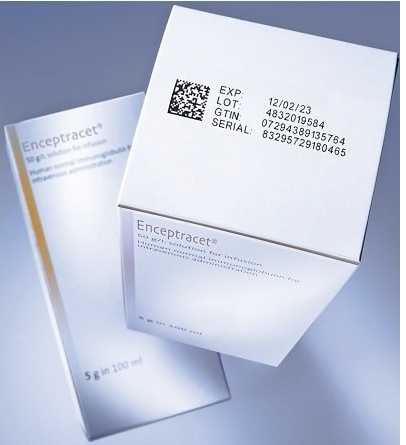Thierry Protas, Global Pharma Director at Videojet Technologies, looks at the importance of the Drug Supply Chain Security Act (DSCSA) legislation, the looming 2018 cut off point for compliance, and how coding and marking is a key consideration.
On 27 November 2013, US Congress enacted The Drug Quality and Security Act (DQSA). Within this legislation, Title II was the Drug Supply Chain Security Act (DSCSA), which outlined‘steps to build an electronic, interoperable system to identify and trace certain prescription drugs as they are distributed in the United States’. The aim was, and is, to enhance FDA’s ability to help protect consumers from exposure to drugs that may be harmful – be they counterfeit, stolen or contaminated, for example – and the system will also improve detection and removal of potentially dangerous drugs from the drug supply chain.
A key component of the product tracing scheme outlined in the DSCSA is the product identifier. In Section 5821 requirements are outlined that each package and homogeneous case of product in the pharmaceutical distribution supply chain must bear a product identifier. This identifier must be encoded with the product’s standardized numerical identifier, lot number, and expiration date by specific dates. The document outlines that ‘under the statute, manufacturers are required to begin affixing or imprinting (adding) a product identifier to each package and homogeneous case of a product intended to be introduced into commerce no later than November 27, 2017.
 This date has of course passed, but are all suppliers of pharma products to the US compliant already? Well, the short answer is no they are not, and it has fallen to the FDA to take a close look at its enforcement deadline to ensure that a large number of companies – particularly small to medium in size – are not restricted from supplying product to the US to the point that supply is affected. The DSCSA therefore introduced an enforcement delay in June of 2017, giving those companies that are not fully compliant until 27 November 2018 to act.
This date has of course passed, but are all suppliers of pharma products to the US compliant already? Well, the short answer is no they are not, and it has fallen to the FDA to take a close look at its enforcement deadline to ensure that a large number of companies – particularly small to medium in size – are not restricted from supplying product to the US to the point that supply is affected. The DSCSA therefore introduced an enforcement delay in June of 2017, giving those companies that are not fully compliant until 27 November 2018 to act.
What the DSCSA Serialization regulations mean for companies operating outside of the US that wish to export to that market
Complying with DSCSA is not linked to the location of a plant, rather the final destination of the product. In other words, if you produce medicines for the US market, you must comply with DSCSA, regardless of where your production line is located. What this means for producers is that an evaluation must be carried out to identify which products have to be compliant, where they are produced, and then to decide how best to manage the serialization requirements on the line.
 This is the very first step a manufacturer must take before even contemplating a draft URS (User requirements and Specifications) document, as this document will vary from one line to another, depending on current production and packaging line equipment, and even more from one plant to another, depending on existing IT architecture.
This is the very first step a manufacturer must take before even contemplating a draft URS (User requirements and Specifications) document, as this document will vary from one line to another, depending on current production and packaging line equipment, and even more from one plant to another, depending on existing IT architecture.
There is huge preparation work to be undertaken before speaking about more technical project management, which is usually undertaken in partnership with an expert external serialization consultant. The issue is that such experts have waiting lists that far outstrip demand, leaving companies somewhat stranded and confused as to how to move forward.
Coding and marking is key to serialization implementation
One element that is constant in serialized operations is coding and marking equipment,without which it would be impossible to operate in this sector, much less be compliant with DSCSA regulations. DSCSA requirements include the usage of Product Identifiers, so for producers it will be vital to check if existing equipment, mainly printers, are able to manage this new message standard.
It also means that some companies may have to evaluate a new coding solution, particularly if their current systems are not able to produce Data Matrix codes at speed. This will also add additional time to an already complex process, potentially writing a specific URS for the printing process, or printing and verifying processes, as code quality is paramount.
Through working with an expert supplier, one that can provide a wide range of printing technologies, producers will be able to define the best printing solution to comply with DSCSA, with the best quality, in a more timely manner.
There is much to consider that can be managed by your supplier, particularly where substrates and choosing the best system for your needs is concerned. Code2Carton, is a prime example of this in action. Videojet, for example, works with a specialist, external laboratory in charge of managing all wipe resistance, light fastness and water resistance tests, meaning the best printer/ink combination (for Thermal Ink Jet – TIJ technology) or the best wavelength (for laser) and the best ribbon (for Thermal Transfer Over-printers – TTO) can be certified and guaranteed compliant to DSCSA. The laboratory provides a formal report, which will allow producers to make sure all tested packaging materials (cartons, labels, Tyvek™) will receive the best solution in terms of both printing technology and consumables, to ensure the minimum grade requirement for at least five years after printing on production lines has commenced.
The Smartphone generation
 As with everything technological in the 21st Century, there is almost certainly ‘an app for that’ – and coding and marking is no exception. The Pharma Line app now gives manufacturers coding solutions for products at their fingertips. Various codes can be viewed on iOS or Android devices on a range of pharmaceutical packaging materials, each of which link to an extensive library of product related materials, such as case studies, white papers, brochures and videos.
As with everything technological in the 21st Century, there is almost certainly ‘an app for that’ – and coding and marking is no exception. The Pharma Line app now gives manufacturers coding solutions for products at their fingertips. Various codes can be viewed on iOS or Android devices on a range of pharmaceutical packaging materials, each of which link to an extensive library of product related materials, such as case studies, white papers, brochures and videos.
This technology allows the process of selecting coding and marking equipment to begin even before first contact has been made with the supplier, and its intuitive nature means it is a simple process to locate and view the combinations that are most relevant and to get a real picture of how a code will appear before a single test has been run.
Regardless of what stage a manufacturer is at in terms of planning for DSCSA regulations, coding and marking will be an integral part of compliance. Engage now, discover what is possible through working with an expert supplier, and reap the rewards when the time comes to integrate the various elements of your serialization solution.
[1] https://www.fda.gov/downloads/Drugs/GuidanceComplianceRegulatoryInformation/Guidances/UCM586509.pdf

















![Sirio Launches Global Research Institute for Longevity Studies [SIA]](https://www.worldpharmatoday.com/wp-content/uploads/2019/09/Sirio-218x150.jpg)




